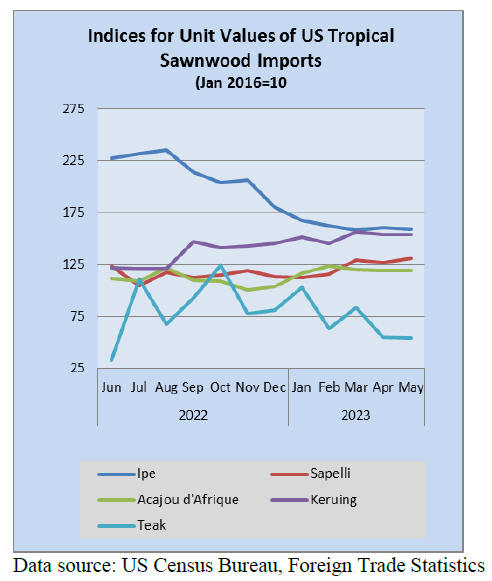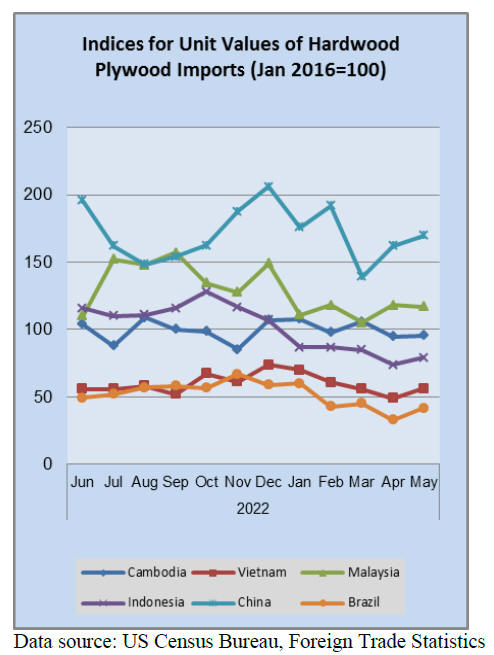|
Report from
North America
Housing starts fell in June but Canada sees
largest jump in 10 years
Single-family homebuilding fell in June but permits for future
construction rose to a 12-month high on the weakness of the existing
home sales market. The decline in housing starts came after a massive
19% surge in May which propelled the number of starts on single-family
projects to an 11-month high. Starts in June dropped to a seasonally
adjusted annual rate of 1.43 million (below economists’ expectations for
1.48 million) according to the US Census Bureau. That was down 8.1% from
a year ago and 8.0% from May.
In June only 600,000 existing homes were listed for sale across the US,
noted Bright MLS Chief Economist, Lisa Sturtevant. “While new
construction will not immediately solve the supply problem in the
housing market, the recovery in the homebuilding industry and the
delivery of more new homes is essential for meeting the nation’s housing
needs and easing housing affordability challenges for prospective home
buyers,” she said.
Overall, single‐family housing starts in June came in at a rate of
935,000, 7% below the revised May figure of 1,005,000. The June rate for
units in buildings with five units or more was 482,000. Issued permits,
an indicator for future completions, also decreased 3.7% overall from
May, and were 15.3% lower from a year ago. But single-family permits
increased (+2.2%) while the more volatile multifamily permits declined
(-12.8%).
The number of single-family homes under construction remains high, while
a record number of multifamily units are under construction even if the
pace of expansion is slowing.
Canadian housing starts rose 41% in June compared with the previous
month, the largest increase in the last 10 years, led by groundbreaking
on multiple unit urban homes, data from the national housing agency
showed. The seasonally adjusted annualized rate of housing starts rose
to 281,373 units in June from a revised 200,018 units in May, the
Canadian Mortgage and Housing Corporation (CMHC) said.
See:
https://www.census.gov/construction/nrc/current/index.html
and
https://www.housingwire.com/articles/housing-starts-surprised-on-the-downside-reflecting-headwinds/
and
https://www.cmhc-schl.gc.ca/professionals/housing-markets-data-and-research/housing-data/data-tables/housing-market-data/monthly-housing-starts-construction-data-tables
Home sales fall and inventory at near historic low
Sales of previously occupied homes in the US fell in June to the slowest
pace since January, as a near-historic low number of homes for sale and
rising mortgage rates kept many would-be homebuyers on the sidelines.
Existing home sales fell 3.3% in June from May’s seasonally adjusted
annual rate of 4.16 million said the National Association of Realtors (NAR).
Sales sank 19% compared to June last year. All told, sales are down 23%
through the first half of this year.
The latest housing market figures are more evidence that, even with
prices easing back after rising for more than a decade, many house
hunters are being held back by a persistently low inventory of homes for
sale. Some 1.08 million homes remained on the market at the end of June,
down 14% from a year earlier said the NAR. That amounts to a 3.1-month
supply at the current sales pace. In a more balanced market between
buyers and sellers, there is a 5- to 6-month supply.
Existing-home sales in the Northeast grew 2.0% from May to an annual
rate of 510,000 in June, down 22% from June 2022. In the Midwest, sales
were unchanged from one month ago at an annual rate of 990,000 in June,
slumping 20% from one year ago. Sales in the South fell 5% from May to
an annual rate of 1.91 million in June, a decrease of 16% from the
previous year. In the West, sales declined 5% from the previous month to
an annual rate of 750,000 in June, down 23% from one year ago.
See:
https://www.nar.realtor/research-and-statistics/housing-statistics/existing-home-sales
US job market cools but continues growth
The US economy added 209,000 jobs in June in yet another monthly jobs
gain but the smallest increase since the end of 2020. The jobs report
cames as market watchers are eyeing the Federal Reserve to see if
interest rate hikes will return to tame inflation amid high employment.
The figures released by the Bureau of Labor Statistics fell short of the
estimated 230,000, while the unemployment rate ticked down to 3.6%, from
3.7 %, near the lowest level in 50 years. His indicates that hiring in
the US is cooling after a recovery from the loss of jobs during the
COVID pandemic.
Employment in construction continued to trend up in June (+23,000).
Employment in the industry has increased by an average of 15,000 per
month thus far this year compared with an average of 22,000 per month in
2022. Employment in manufacturing showed no significant change in June.
See:
https://www.bls.gov/news.release/empsit.nr0.htm
and
https://www.msn.com/en-us/money/markets/us-hiring-falls-below-expectations-with-209-000-jobs-added-in-june/ar-AA1dz1Xn
Consumer sentiment rises to best level in two years
Consumer sentiment in July rose to its highest level since 2021 a survey
by the University of Michigan found. The mid-July report showed that job
prospects and lower inflation have consistently boosted consumer
sentiment about economic conditions in recent months.
Consumer sentiment rose for the second straight month, soaring 13% above
June and reaching its most favorable reading since September 2021 the
preliminary survey from the University of Michigan says, adding “the
sharp rise in sentiment was largely attributable to the continued
slowdown in inflation along with stability in labour markets."
All components of the index improved from June levels with optimism
increasing by 19% for long-term business conditions. For consumers, the
sentiment improved for all but low-income households.
Headline inflation in the US moved to its lowest point since early 2021,
rising 3% over the 12-month period to June. So-called core inflation,
which strips out volatile food and energy prices, was at 4.8% annually
to June, only slightly lower than in May.
See:
http://www.sca.isr.umich.edu/
US manufacturing troubles worsen
US manufacturing activity fell for the eighth consecutive month in
June according to the latest Manufacturing Institute of Supply
Management (ISM) Report On Business.
The ISM survey placed the manufacturing PMI gauge at 46 in June, down
from 47 in May and falling short of estimates (a rating below 50
reflects contraction). The latest June ISM Manufacturing PMI marked the
lowest point since May 2020, when business activity plummeted due to
Covid-19 restrictions.Timothy R. Fiore, chair of the ISM Manufacturing
Business Survey Committee said “Demand remains weak, production is
slowing due to lack of work, and suppliers have capacity.
There are signs of more employment reduction actions in the near term.”
The most recent data confirms the stark contrast between the
manufacturing sector’s contraction and the service sector’s continued
expansion.
Of the 18 manufacturing sectors surveyed the Wood Products sector was
among the 11 reporting contraction for the month while the Furniture and
Related Products sector reported neither growth nor contraction in June.
After several months of decline the furniture sector reported some
encouraging findings: Furniture and Related Products reported an
increase in orders for the second consecutive month as well as growth in
production and employment in June.
See:https://markets.businessinsider.com/news/etf/us-manufacturing-crisis-worsens-activity-shrinks-for-8th-straight-month-to-lowest-in-3-years-1032423762
and
https://www.ismworld.org/supply-management-news-and-reports/reports/ism-report-on-business/pmi/march/
Hardwood plywood from Vietnam ruled as a product of China- duties
imposed
The US Department of Commerce issued its final determination that
hardwood plywood exported from Vietnam using hardwood plywood inputs
sourced from China is, in fact, a product of China. That means the
plywood is subject to the antidumping duty (AD) and countervailing duty
(CVD) orders on hardwood plywood from China. The Commerce Department’s
International Trade Administration published notice of its determination
July 20 in the Federal Register.
Thirty-seven companies were found to have failed to cooperate or failed
to respond to the agency's investigation. The Commerce Department
ordered US Customs and Border Protection to collect cash deposits from
these 37 companies at the China-wide rates of 183% for AD and 23% for
CVD.
In its ruling, the US Department of Commerce "determines that imports of
certain hardwood plywood products (hardwood plywood), completed in the
Socialist Republic of Vietnam (Vietnam) using plywood inputs and
components (face veneer, back veneer, and/or either an assembled core or
individual core veneers) manufactured in the People’s Republic of China
(China), are circumventing the antidumping duty (AD) and countervailing
duty (CVD) orders on hardwood plywood from China."
The Coalition for Fair Trade of Hardwood Plywood brought the
circumvention case against imports from Vietnam in 2020 after imports
from Vietnam spiked following the imposition of antidumping and
countervailing duties on China.
See:https://www.decorativehardwoods.org/sites/default/files/2023-07/US%20Department%20of%20Commerce%20Ruling%20on%20Vietnam%20Circumvention%204403527-01%20%281%29.pdf
and
https://www.woodworkingnetwork.com/news/woodworking-industry-news/certain-hardwood-plywood-vietnam-ruled-product-china-subject
and
https://www.decorativehardwoods.org/sites/default/files/2023-07/Coalition%20for%20Fair%20Trade%20in%20Hardwood%20Plywood%20Vietnam%20Press%20Release%20-%20final%20%281%29.pdf
Canadian wildfires expected to drive up US timber prices
Canada’s devastating wildfire season has impacted the largest amount of
land ever recorded in a single year. As a result timber prices are
expected to rise as Canada supplies approximately 80% of US softwood
sawnwoodimports. However, it is too early to know how much of the
affected areas include harvestable timber, as well as how much will be
damaged in the coming months.
The Canadian provinces of Alberta and Quebec have been hit the hardest
by the fires so far with around 3.8 million and 3.5 million acres burnt,
respectively. Together, they account for 44% of Canada’s annual softwood
sawnwood shipments to the US and 45% of total production. Canada’s
weather conditions are expected to fuel more wildfires throughout the
summer, which paints a grim outlook for timber prices.
See:
https://www.globalwood.org/news/2023/news_20230720a.htm


|